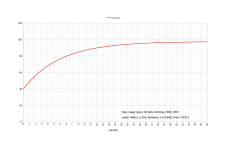The temp rise tables are flawed. It is assuming that there will be a 12.5V drop in the wire. I'll dumb the math a little, 10V at 400A is 4000 watts of energy. That sounds correct for the heat rise calculations. But you are not dropping 12V (or my dumbed down 10V) across the wire. You are dropping 1V, and only at full load. So that 4kw heating element of copper wire is now only 400W of heating element. And there is a lot of thermal mass and a lot of surface area to dissipate that heat. It will get slightly warm. But the winch will burn out or the battery will be dead well before the power lead is anywhere near overheated.
The voltage drop is calculated but for heating it's not used. The 12.5V in the chart indicates the forcing voltage I assumed. I could put it at 10V or 14V. It doesn't matter for the temp rise. I include it only as reference so I can calculate a percent drop.
In fact the simplified MIL-W-5088 for temp rise requires only current and constant "K" per wire gauge that was I believe found originally empirically and given there in a chart for allowable conductor current. I just derived this constant and put into a spreadsheet for myself so I could reverse the calculation. This method would though have to presume teflon insulation at specific wall thickess to be completely valid. Most ampacity recommendations seem a variation of this techique and found experimentally with a particular margin of safety added (NEC is very conservative for example).
So for the purposes of the charts I've derived a formula that relates current, time, resistance, mass (e.g. based on diameter or thickness) and specific heat. It's essentially an expansion of the standard exponential heating formula. I have reasonably precise material data for EPDM, PVC, XLPE insulation for use on insulated or bare copper and aluminum. For SXL/TXL/GXL I have a best guess thermal resistance value.
A conductor's temperature (and therefore relatedly the current carrying capacity) isn't just simply that of copper. The jacket insulates and keeps heat in so it will run significantly warmer than bare wire. Heat is conducted through (or resisted by, depending on your perspective) the insulation and dissipated into air. It's not simple to do analytically and I do not claim what I've done is absolutely accurate. I am most definitely
not a thermodynamics professor, just a practicing engineer. Electrical at that, not even a mechanical or chemical to
really understand the physics. I treat this topic as I would any heat sink calculation, a heat source with a combination of basically ideal materials and interfaces (thus given or calculated thermal resistances) until I reach free air.
If you and
@1stDeuce want to discuss this in more detail (I don't want to put my work into the public domain) I'm happy to talk about better ways to calculate this but I have closed the loop casually on a few final designs, the method worked for my purposes so I just offered it for what's it worth since it allows flexibility in selecting wire size and insulation type instead of the options canned tables allow and will have no derating included. The value is what it is, the designer can choose the margin. The most significant weakness I can see in what I've done is that it does not factor for surface area or skin. I toyed with that but that seemed to really steer into the weeds without adding to the usefulness of the tool. Assuming the conductor and insulation are homogeneous lumps seemed to work well enough for the task.





